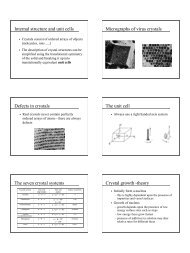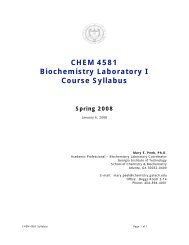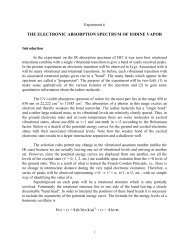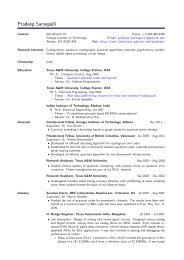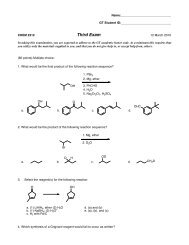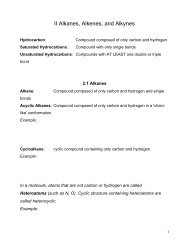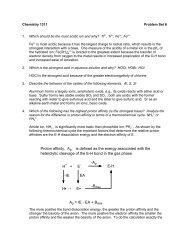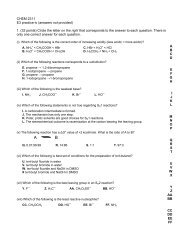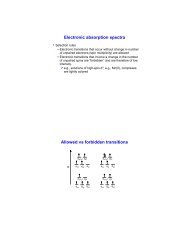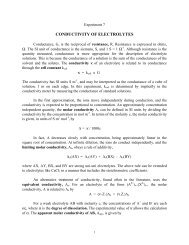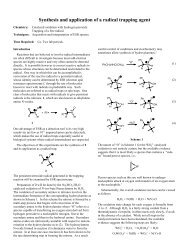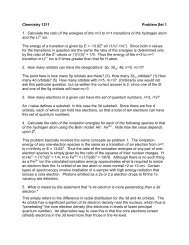Catalyzed Cross-Coupling of a Grignard Reagent with an Aryl Halide
Catalyzed Cross-Coupling of a Grignard Reagent with an Aryl Halide
Catalyzed Cross-Coupling of a Grignard Reagent with an Aryl Halide
- No tags were found...
You also want an ePaper? Increase the reach of your titles
YUMPU automatically turns print PDFs into web optimized ePapers that Google loves.
<strong>Catalyzed</strong> <strong>Cross</strong>-<strong>Coupling</strong> <strong>of</strong> a <strong>Grignard</strong> <strong>Reagent</strong> <strong>with</strong> <strong>an</strong> <strong>Aryl</strong> <strong>Halide</strong>A carbon-carbon forming reactionObjectives:Generate a new carbon-carbon bond by the nickel-catalyzed cross-coupling <strong>of</strong> bromobenzene <strong>an</strong>d isopropylmagnesium chloride (C)Prepare/characterize a coordination compound for use as catalyst for the coupling reaction (C)Determine the effect <strong>of</strong> lig<strong>an</strong>d on the regiochemistry <strong>of</strong> the cross-coupling reaction (C)Analyze products <strong>of</strong> catalytic reaction by gas chromatography (T)Time Required:Four lab periods.IntroductionA variety <strong>of</strong> tr<strong>an</strong>sition metal catalyzed reactions have beendeveloped to effect nucleophilic substitutions in aromaticsystems, 1 which occur very slowly, if at all, by direct reaction <strong>of</strong>aryl substrate <strong>an</strong>d nucleophile. Catalysts for such reactionsinclude a variety <strong>of</strong> compounds that contain Group VIII metals,<strong>with</strong> nickel <strong>an</strong>d palladium being the most common. Thesereactions are ideally suited for normal synthetic applicationssince the catalysts are usually air stable materials that have a longshelf life. Nickel catalysts are particularly effective in catalyzingthe cross-coupling reaction <strong>of</strong> <strong>Grignard</strong> reagents <strong>an</strong>d aryl halides,which this experiment will illustrate <strong>with</strong> the reaction <strong>of</strong> C 6 H 5 Br<strong>an</strong>d (CH 3 ) 2 CHMgCl. This experiment will also illustrate theimport<strong>an</strong>ce <strong>of</strong> lig<strong>an</strong>d on the regiochemistry <strong>of</strong> the couplingreaction.The coupling reaction is generally performed by heating thethe aryl halide, about 5 mol percent <strong>of</strong> catalyst, <strong>an</strong>d excess<strong>Grignard</strong> reagent until a high conversion <strong>of</strong> aryl halide to producthas been achieved. The generally accepted mech<strong>an</strong>ism for thenickel catalyzed coupling <strong>of</strong> aryl halides <strong>with</strong> <strong>Grignard</strong> reagentsis the following:L 2 NiX 2 + 2 RMgXThe conversion <strong>of</strong> L 2 NiX 2 to L 2 Ni requires some discussion.Bisphosphinenickel(II) alkyl complexes, especially those inwhich the alkyl groups contain A-hydrogens, have only limitedthermal stability, <strong>an</strong>d undergo reductive elimination reactionsthat result in the formation <strong>of</strong> Ni(0) complexes, i.e.,LLNiLLL 2 Ni + C 6 H 14HNiL 2 Ni + C 3 H 8 + C 3 H 6There are two pathways for reductive elimination. The firstinvolves C-C bond formation between the two alkyl groups. Ifthere are no A-hydrogens this is the only way that reduction c<strong>an</strong>occur. The second involves A-hydrogen elimination from one <strong>of</strong>the alkyl substitutents (butyl in the example), which does notresult in a ch<strong>an</strong>ge in the formal oxidation state <strong>of</strong> the nickel atom,followed by reductive elimination <strong>of</strong> prop<strong>an</strong>e <strong>an</strong>d dissociation <strong>of</strong>propene.The presence <strong>of</strong> A-hydrogen atoms in the <strong>Grignard</strong> reagent c<strong>an</strong>result in loss <strong>of</strong> regiochemistry in the cross-coupling reaction<strong>an</strong>d/or hydrogenolysis <strong>of</strong> the aryl halide as shown in thefollowing modification <strong>of</strong> the earlier catalytic cycle.L 2 NiX 2 + 2 RMgXL 2 NiPhXL 2 NiPhXPhLNiPh LL X NiL PhXMgMgX 21Diederich, Fr<strong>an</strong>cois. <strong>an</strong>d St<strong>an</strong>g, Peter J. “Metal catalyzedcross-coupling reactions” New York : Wiley-VCH, 1998.LNiLPhPhPhPhH+LNiLHLNiLPhPhLNiLMgX 2XPhXMgThe extent to which either <strong>of</strong> these unw<strong>an</strong>ted processes occurs ishighly dependent upon the nature <strong>of</strong> the lig<strong>an</strong>ds bound to thenickel, although not necessarily in a predictable fashion.In this experiment you will be assigned nickel complex A or1
B to prepare <strong>an</strong>d characterize.Ph PhBrP ClNiNiPh 3 PBrP ClPPh 3Ph PhA BCharacterization will involve obtaining <strong>an</strong> elemental <strong>an</strong>alysis fornickel. You will then use the complex that you have prepared forthe catalyzed cross-coupling <strong>of</strong> C 6 H 5 Br <strong>an</strong>d (CH 3 ) 2 CHMgCl.Commercial <strong>Grignard</strong> reagent will be used for the reaction.Because <strong>of</strong> the sensitivity <strong>of</strong> the <strong>Grignard</strong> reagent to water <strong>an</strong>dthe catalytically active nickel(O) species to oxygen <strong>an</strong>d water itwill be necessary to use techniques designed to protect thereagents from the atmosphere.ProcedureThere are several reactions <strong>an</strong>d procedures to be done for thisexperiment. Pl<strong>an</strong> your work according to the following schedule.Individual procedures follow. First lab period: (1) Prepare thenickel complex assigned to you using the appropriate procedure.(2) Determine the magnetic susceptibility <strong>of</strong> your complex.Second lab period: (1) Conduct the cross-coupling reaction. (2)Do gas chromatographic <strong>an</strong>alyses <strong>of</strong> st<strong>an</strong>dards. Third labperiod: Determine the product distribution <strong>an</strong>d yield by gaschromatography.Dibromobis(triphenylphosphine)nickel(II). Add 1.4 g <strong>of</strong>nickel bromide trihydrate to 20 mL <strong>of</strong> 1-but<strong>an</strong>ol in a 50 or 125mL Erylenmeyer flask, heat it to boiling <strong>an</strong>d maintain it atboiling until the nickel salt dissolves. Filter this solution ifparticulates are present. Add 2.7 g <strong>of</strong> triphenylphospine to 20mL <strong>of</strong> 1-but<strong>an</strong>ol in a second Erylenmeyer flask (50 or 125 mL asavailable) <strong>an</strong>d heat the mixture until the triphenylphospinedissolves <strong>an</strong>d the solution boils. Add the triphenylphosphinesolution to the boiling nickel bromide solution <strong>an</strong>d allow thesolution to cool in <strong>an</strong> ice bath. Collect the green product byfiltration, wash <strong>with</strong> a small amount <strong>of</strong> ether, <strong>an</strong>d dry the productby pulling air over it for 15-20 min. Record the yield <strong>an</strong>dproceed to the determination <strong>of</strong> magnetic susceptibility. Submitthe sample <strong>with</strong> your report.Dichlorobis(1,2-diphenylphosphino)eth<strong>an</strong>enickel(II). Place1.5 g <strong>of</strong> NiCl 2 ]6H 2 O <strong>an</strong>d 15 mL <strong>of</strong> eth<strong>an</strong>ol in a 50 mLErylenmeyer flask along <strong>with</strong> a magnetic stirring bar. Warm thesolution on a hot plate <strong>an</strong>d stir until the nickel salt dissolves.Remove the flask from the heat <strong>an</strong>d add 1.2 g <strong>of</strong> 1,2-diphenylphosphinoeth<strong>an</strong>e to the flask <strong>an</strong>d return it to the hotplate. Precipitation <strong>of</strong> product will begin immediately. Stir thesolution <strong>an</strong>d maintain it at about 60 °C for 20 min taking care.that the volume does not drop below 10 mL. Add smallqu<strong>an</strong>tities <strong>of</strong> eth<strong>an</strong>ol as required. Remove the flask from the heat<strong>an</strong>d allow the solution to cool to room temperature. Collect theproduct by suction filtration <strong>an</strong>d wash it <strong>with</strong> 5 mL <strong>of</strong> eth<strong>an</strong>ol<strong>an</strong>d 10 mL <strong>of</strong> ether <strong>an</strong>d draw air over the solid for 15-20 min todry it. Record the yield <strong>an</strong>d proceed to the determination <strong>of</strong>magnetic susceptibility. Submit the sample <strong>with</strong> your report.Prelab: How m<strong>an</strong>y mL <strong>of</strong> 2.0 M isopropyl <strong>Grignard</strong> isrequired to obtain 12.5 mmol?<strong>Cross</strong>-coupling <strong>of</strong> bromobenzene <strong>an</strong>d isopropylmagnesiumbromide. The cross-coupling reagent should be done using 10mmol <strong>of</strong> bromobenzene, 1.5 mol percent catalyst, <strong>an</strong>d a 25%excess <strong>of</strong> <strong>Grignard</strong> reagent (12.5 mmol). Use the concentrationon the bottle <strong>of</strong> reagent to recalculate the qu<strong>an</strong>tity. Fit a 100 mLthree-necked flask (all glassware should be oven-dried) <strong>with</strong> 25mL pressure-equalizing dropping funnel, reflux condenser <strong>with</strong>nitrogen inlet system, <strong>an</strong>d magnetic stirring bar. Flush the flask<strong>an</strong>d dropping funnel <strong>with</strong> nitrogen <strong>an</strong>d then add thebromobenzene, catalyst, <strong>an</strong>d 10 mL <strong>of</strong> nitrogen or argon spargedether to the flask. Use a syringe <strong>an</strong>d cle<strong>an</strong> 18-gauge needle to<strong>with</strong>draw the appropriate volume <strong>of</strong> <strong>Grignard</strong> reagent <strong>an</strong>d addthis to the dropping funnel. Be sure that the dropping funnelstopcock is closed. Safety: Take care not to “inject” yourselfor <strong>an</strong>yone else <strong>with</strong> the needle, <strong>an</strong>d be careful not to spill the<strong>Grignard</strong> on your skin. As soon as the syringe is emptied, takeit to the hood <strong>an</strong>d remove the plunger. After a few minutes, washall components <strong>with</strong> water <strong>an</strong>d then <strong>with</strong> a small amount <strong>of</strong>meth<strong>an</strong>ol or acetone <strong>an</strong>d return them to the oven.While stirring the mixure in the flask, slowly add the <strong>Grignard</strong>reagent to the reaction mixture. After addition is complete, heatthe mixture to gentle reflux <strong>an</strong>d maintain the reflux for 2 h.Allow the reaction mixture to cool to room temperature (adjustthe nitrogen flow so that bubbler oil is not drawn into the systemduring cool down). Add 15 mL <strong>of</strong> water to the separatory funnel<strong>an</strong>d then to the flask to destroy <strong>an</strong>y unreacted <strong>Grignard</strong> reagent.Tr<strong>an</strong>sfer the mixture to a separatory funnel <strong>an</strong>d separate theorg<strong>an</strong>ic layer (more ether may be added to aid in the separationif needed). Wash the aqueous layer <strong>with</strong> 15 mL <strong>of</strong> fresh ether<strong>an</strong>d combine the two ether fractions. Wash the combined etherextracts twice <strong>with</strong> 15 mL portions <strong>of</strong> saturated aqueous sodiumthiosulfate <strong>an</strong>d twice <strong>with</strong> 15 mL portions <strong>of</strong> water <strong>an</strong>d then dryover <strong>an</strong>hydrous MgSO 4 . This solution will be used fordetermining the distribution <strong>an</strong>d amounts <strong>of</strong> products. Reservethis solution until the next laboratory period for <strong>an</strong>alysis <strong>of</strong> theproducts.Determination <strong>of</strong> magnetic moment the for nickel catalyst.Use the Magnetic Susceptibility Bal<strong>an</strong>ce to determine the masssusceptibility <strong>of</strong> your complex. Use the value obtained tocalculate the magnetic moment in the same fashion as you didearlier for [Ni(en) 3 ](BF 4 ) 2 . The procedure for operation <strong>of</strong> themagnetic susceptibility bal<strong>an</strong>ce is given in Appendix I.Gas chromatographic <strong>an</strong>alysis <strong>of</strong> st<strong>an</strong>dards. Based upon theearlier discussion <strong>of</strong> the mech<strong>an</strong>ism <strong>of</strong> the cross-couplingreaction the ether extracts should contain some combination <strong>of</strong>bromobenzene (unreacted starting material), isopropylbenzene(desired product), propylbenzene (isomerized product,undesired) <strong>an</strong>d benzene (reduction product, also undesired). Todetermine which <strong>of</strong> these products are present it will be necessaryto determine the retention times <strong>of</strong> each <strong>an</strong>d compare theretention times <strong>of</strong> peaks in the sample <strong>with</strong> those <strong>of</strong> the2
st<strong>an</strong>dards. It is a good idea to directly compare a chromatogram<strong>of</strong> a synthetic mixture <strong>of</strong> the possible products <strong>with</strong> one for thesample, particularly if retention times <strong>of</strong> products are quitesimple. Although it is possible to determine relative amounts <strong>of</strong><strong>of</strong> the components in the mixture by the relative areas under thepeaks corresponding to each, a qu<strong>an</strong>titative determinationrequires that a known amount <strong>of</strong> a reference material be added tothe sample, which must be contained in a known volume.Obviously the retention time <strong>of</strong> the reference material must beknown <strong>an</strong>d it must different from that <strong>of</strong> <strong>an</strong>y component <strong>of</strong> themixture. Mesitylene will be used as the reference material(internal st<strong>an</strong>dard) for this <strong>an</strong>alysis. In this <strong>an</strong>alysis we willassume that the response <strong>of</strong> the detector to each component is thesame per unit mass although this is definitely <strong>an</strong> assumption <strong>an</strong>dresponse factors (area sample/unit mass)/(area reference/unitmass) should be determined for more exact work.You must determine retention times for each <strong>of</strong> the followingbenzene, bromobenzene, isopropylbenzene, propylbenzene <strong>an</strong>dmesitylene. Identify each on the a chromatograph <strong>of</strong> thereference mixture that is supplied.Product <strong>an</strong>alysis. Weigh about 5 mmol <strong>of</strong> mesitylene into a 50mL volumetric flask, then filter the ether extracts into the flask<strong>an</strong>d add enough ether to bring the volume to the mark. Obtainthe gas chromatograph <strong>of</strong> the sample, identify the components,determine the areas under the peaks, calculate the molar amounts<strong>of</strong> each component in the ether extract, <strong>an</strong>d <strong>an</strong>d the percent yield<strong>of</strong> propylbenzene. Submit the chromatograms <strong>of</strong> your samplePrelab: Calculate the molar amounts <strong>of</strong> components A <strong>an</strong>dB in a mixture given that their peak areas are 20 <strong>an</strong>d 135,respectively, <strong>an</strong>d the area <strong>of</strong> the internal st<strong>an</strong>dard (0.003mmol) is 62. The volume <strong>of</strong> the solution was 100 mL.along <strong>with</strong> those <strong>of</strong> the st<strong>an</strong>dards <strong>an</strong>d the st<strong>an</strong>dard mixture <strong>with</strong>your report.When preparing your report you should use your own data incalculating percent conversion to products. You should alsoconsider your own product distribution relative to the average <strong>of</strong>the product distributions for all people employing the samecatalyst that you have used. Finally, you should comment on theaverage product distribution obtained <strong>with</strong> your catalyst incomparison <strong>with</strong> that for the other catalyst.Use the appended Excel spread sheet to record your data <strong>an</strong>dsend it as <strong>an</strong> email attachment to the lead instructor for theexperiment.3
Appendix IOperation <strong>of</strong> the Magnetic Susceptibility Bal<strong>an</strong>ceThe magnetic susceptibility bal<strong>an</strong>ce operates on the Gouyprinciple as previously described except the sample remainsstationary <strong>an</strong>d the magnetic moves. To see a schematic <strong>of</strong> theinternal workings <strong>of</strong> the bal<strong>an</strong>ce see the m<strong>an</strong>ufacturer’s web sitehttp://www.sherwood-scientific.com/msb/shmagway.html.Be sure that the tube is cle<strong>an</strong> <strong>an</strong>d dry (inside <strong>an</strong>d out): wipe it<strong>with</strong> a tissue or cle<strong>an</strong> <strong>with</strong> a "pipe cle<strong>an</strong>er" if it is not.The major error in this method most <strong>of</strong>ten arises frominhomogeneous packing. The sample should be in the form <strong>of</strong> areasonably fine <strong>an</strong>d uniform powder. (Large crystals c<strong>an</strong>not bepacked homogeneously <strong>an</strong>d errors may also arise from magnetic<strong>an</strong>iostropy. Very fine powders, on the other h<strong>an</strong>d, may packunevenly unless compacted.) Lightly crush <strong>an</strong>y crystallineaggregates <strong>with</strong> a plastic spatula. Introduce a small portions <strong>of</strong>the solid into the weighed sample tube, <strong>an</strong>d tap the bottom <strong>of</strong> thetube gently on the card beside the bal<strong>an</strong>ce a few times to shakethe solid down. (The sample tube is fragile <strong>an</strong>d expensive!!)Repeat this procedure until the depth <strong>of</strong> sample is at least 15 mm.Measure the sample length , making sure that the top <strong>of</strong> thesample is horizontal. Do not include the thickness <strong>of</strong> the glass atthe bottom <strong>of</strong> the tube.Record the mass <strong>of</strong> the tube plus sample <strong>an</strong>d determine the mass<strong>of</strong> the sample.Turn the bal<strong>an</strong>ce on <strong>an</strong>d let it stabilize. Place the spare tube inthe bal<strong>an</strong>ce <strong>an</strong>d once the bal<strong>an</strong>ce zeros press the r<strong>an</strong>ge buttononce <strong>an</strong>d then the tare button to record the parameters for thebl<strong>an</strong>k tube in memory.Replace the empty tube <strong>with</strong> the tube containing your sample.After the bal<strong>an</strong>ce stabilizes record the value obtained, which isthe volume susceptibility. However, by introducing the length<strong>an</strong>d mass <strong>of</strong> the sample the instrument will calculate a masssusceptibility (the diameter <strong>of</strong> the sample column is determinedby the tube which the instrument senses).Press the “length” button <strong>an</strong>d enter the sample length asdetermined above. After entering the appropriate value thereading will return to the volume susceptibility value.Press the “weight” button <strong>an</strong>d enter the sample mass. Afterentering the appropriate value the reading will return to thevolume susceptibility value.Press the “Mag Sus” button to display the mass susceptibilityvalue. Press the key again to return to the volume susceptibility.Empty <strong>an</strong>d repack the tube (use the same sample) <strong>an</strong>d repeat theprocedure at least once more.4




